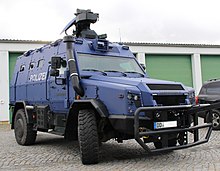SWAT vehicle
This article needs additional citations for verification. (December 2024) |

A SWAT vehicle, police armored vehicle, or police rescue vehicle is a non-military armored vehicle used by police tactical units to respond to incidents. They are most often in configurations similar to military light utility vehicles, infantry mobility vehicles, or armoured personnel carriers. They are generally designed to have armor that can sufficiently block high-caliber rounds, space to carry the unit's equipment, and sufficient passenger seating; some also allow for additional personnel to hang onto the side of the vehicle in transit.
Production
[edit]A SWAT vehicle may simply be an unarmored van, SUV or truck used to transport equipment or officers or used as a command post. Other more specialized vehicles may be armored personnel carriers or MRAPs designed allow officers to operate in situations where armed confrontation is likely.
Specialized heavy-duty commercial vehicles can be up-fitted and built solely as SWAT vehicles, such as the Lenco BearCat, a popular SWAT vehicle used by police forces across North America and worldwide.
Ambulances and armored trucks can also be converted into SWAT vans or trucks. De-militarized armored personnel carriers can be used for this purpose, as is the case with the Phoenix Police Department which used an M113 armored personnel carrier as part of its inventory, or the Florida Highway Patrol which has three Cadillac Gage Commandos.
By country
[edit]France
[edit]
Among other armoured vehicles, the SWAT units of the French National Police RAID and Research and Intervention Brigade (BRI) are equipped with different armoured vans, such as Panhard PVP, former armored cash transport car,[1] and infantry mobility vehicles such as Nexter Titus.[2]
Germany
[edit]
Armoured police vehicles were first introduced after World War I by German police forces, who had more than hundred armoured vehicles called German: Sonderwagen (German for special automobile). Nowadays the Federal Police and the state police forces still maintain armoured vans, like Sonderwagen 4 and Sonderwagen 5. The federal police recently[when?] also ordered the LAPV Enok in addition to its Mowag Eagle and ATF Dingo. The SEK special state police units use armored vehicles like the LAPV Enok and the Survivor R.[3][4][5]
Japan
[edit]
Riot Police Units have been operating some series of Armoured buses (警備車, Keibi-sha), mainly used as mobile shelters and barriers. More heavily-armored vehicles called Special Armored Vehicles (特型警備車, Tokugata-keibi-sha) were introduced in the 1960s. The first deployed model was called Type F-3, based on Mitsubishi's cab-after-engine trucks. They were initially treated as idlers because there are only few reports of gun violence in Japan, but they were highly appreciated during the Asama-Sansō incident in 1972 and their significance were widely recognized.[6]
After several model changes, Type PV-2 based on the Mitsubishi Fuso Canter is now deployed nationwide, mainly for anti-firearms squads. There are also simplified versions called Special Armored Van (特型遊撃車, Tokugata-yūgeki-sha), and much larger Heavy Special Armored Vehicle (銃器対策警備車, Jūki-taisaku-keibi-sha); the latter is dedicated to the Special Assault Teams.[6]
United Kingdom
[edit]
Police in the United Kingdom, particularly the Police Service of Northern Ireland (PSNI), has a great number of police role armoured vehicles based upon a range of base platforms including the Land Rover Defender and the OVIK Crossway. The internal security situation in Northern Ireland demands that the police operate up to 450 armoured vehicles which are optimised for public order duties. The PSNI uses OVIK Pangolin armoured public order vehicles. UK Police are seeing upgrades within their fleet across the different forces, with West Yorkshire Police acquiring two Lenco Bearcats, popular with United States Law Enforcement agencies.
United States
[edit]SWAT units may also employ ARVs (Armored Rescue Vehicle[7]) for insertion, maneuvering, or during tactical operations such as the rescue of civilians, officers, firefighters, and/or military personnel pinned down by gunfire. To avoid detection by suspects during insertion in urban environments, SWAT units may also use modified buses, vans, trucks, or other seemingly normal vehicles. During the 1997 North Hollywood shootout, LAPD SWAT commandeered an armored cash-delivery truck, which they used to extract wounded civilians and officers from the raging firefight with the heavily armed bank robbers.
See also
[edit]References
[edit]- ^ "Un fourgon de la Brinks transformé en véhicule blindé pour la police". ici, par France Bleu et France 3 (in French). 8 December 2017. Retrieved 3 April 2023.
- ^ "La brigade de recherche et d'intervention". Direction régionale de la police judiciaire de la préfecture de police de Paris (in French). Archived from the original on 17 December 2013. Retrieved 28 July 2023.
- ^ "Nachrichten aus Hamburg". Archived from the original on 14 November 2017.
- ^ "Innenminister übergibt sondergeschütztes Gruppenfahrzeug an Spezialeinheiten".
- ^ "Polizei Sachsen - Fehler".
- ^ a b Kikuchi, Masayuki [in Japanese] (9 June 2018). テロへの備え、警察の「特型警備車」誕生の背景 [Preparing for Terrorist attacks - Background of the birth of the Special Armored Vehicles]. TrafficNews.jp (in Japanese).
- ^ "Guidelines for Armored Rescue Vehicles". 1 January 2008. Archived from the original on 5 November 2012. Retrieved 25 January 2011.
